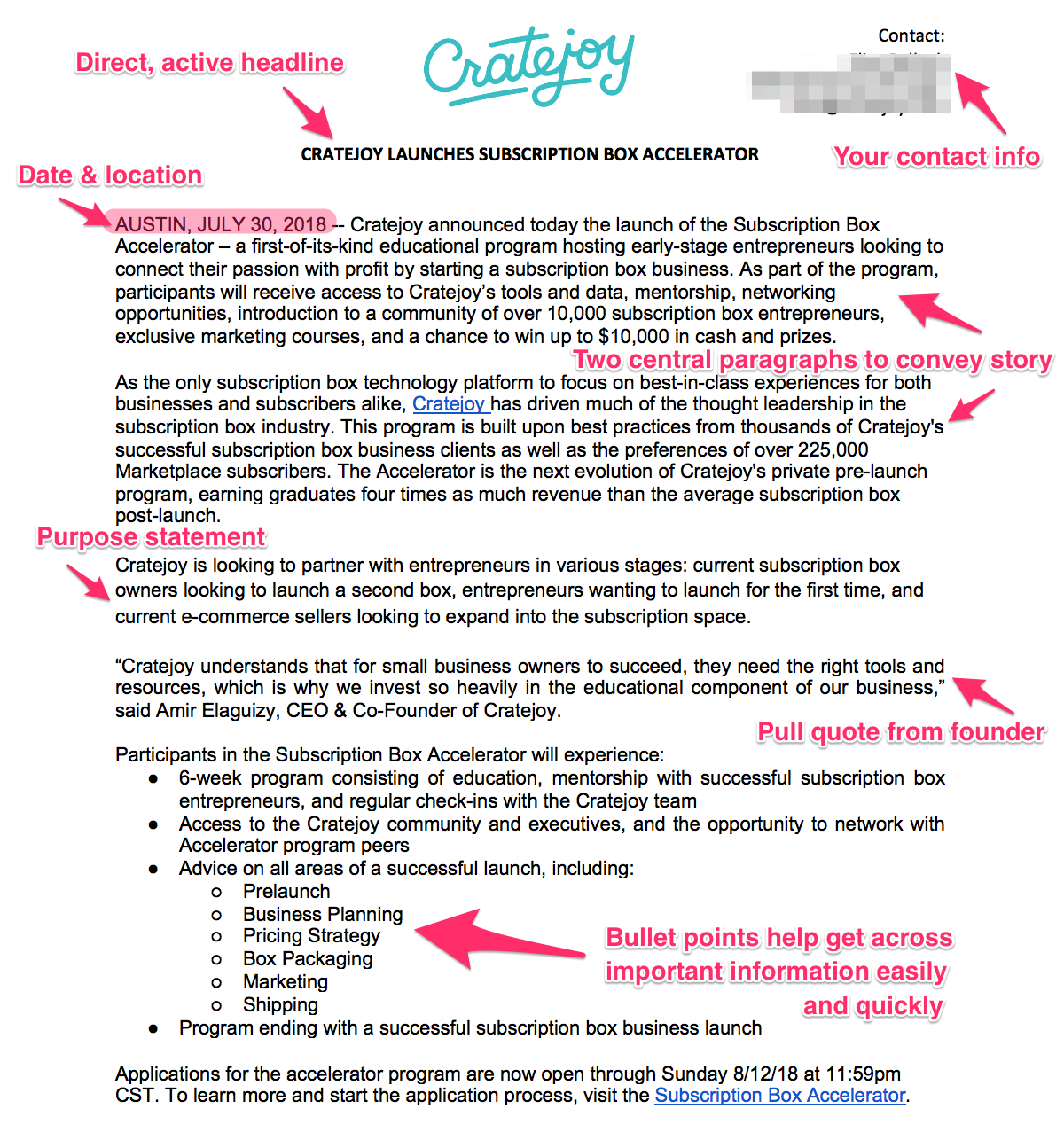Getting press coverage for your subscription box business can seem more difficult, at times, than launching in the first place. How do you get your brand out there and gain media exposure when you’re brand-new? Even if your business isn’t new, it’s hard to break into the media industry if you don’t have connections.
Think of what you learned about reportage when you were growing up. Each story needs a what, where, when, why and how – and the journey to secure press coverage or connections for your business, like any other, requires these too.
Today, we’ll cover:
What Are You Looking to Gain from Coverage? (And When Do You Want to Do It?)

As with all endeavors in small business ownership, you need a clear goal for why you want to pursue media coverage. What do you hope to gain from getting your brand name in print (or on TV, as the case may be)? Do you want to broaden your brand reach, earn more followers on social media, increase your email leads for marketing purposes, or gain more subscriber conversions? Your goal will help you narrow down which route to take and sell your story to press.
After all, you’ll want to come off a certain way in any stories your brand is featured in. Think about how you can portray your business based on that goal.
We also recommend developing a realistic timeline for this goal. It may take a while to earn media exposure – after all, reporters at any media outlet are likely to receive press releases from multiple businesses a day. If they write for a popular or esteemed, well-known publication (for example, on the national level), it’s possible they receive hundreds a day. Keep that in mind as you draft your media strategy and intentions. You may need to revise your approach – or press materials – as you go.
Who Do You Know? (And Where Do They Work?)
![]()
Yes, we mean networking. It may not be everyone’s favorite activity, but it’s important for any business, especially in the PR world. Maybe you have a friend of a friend who writes for a certain outlet or (for instance) does tech stuff for a local radio/TV station. If that’s the case, reach out to them! See if they know anyone who covers a beat relative to your subscription’s niche.
Whether you have a connection to a media outlet or not, it’s a good idea to gather a list of media contacts. By “media contacts,” we mean contact info for the specific people in the department(s) relevant to your niche or brand story – not the general tip line or department email address. Emails sent to a generic/departmental alias are often sent to multiple people in that part of the media company. As such, your email may be ignored or lost in the shuffle… or worse, deleted in a recipient’s annoyance.
In other words, you should personalize your pitch when you reach out to a media contact. Address your query to the correct person and indicate some familiarity with their previous work in your niche.
TL;DR: Do your research before contacting anybody.
Resources
There are plenty of resources online to help you find journalists or other press representatives to publicize your story. Here are a few:
HARO
An abbreviation for Help a Reporter Out, this operation is basically a mass mailing list for potential press sources. If you register for HARO’s list as a useful source in your niche, you’ll get an automated email 3x/day (Monday through Fridays) asking for sources on a variety of subjects. When you come across a source request that meets your niche or another area of your expertise, you can reply that journalist directly from the automated email with a pitch that answers their questions. Read HARO’s guidelines for sources here.
Due to Twitter’s immediacy, a ton of reporters and other media/content producers use the site extensively for their job. Follow media reps in your area, your industry, and your niche! Engage with them on Twitter by RT’ing their stories or commenting and your name will become familiar to them; they may even follow you back. After you’ve done this for some time, feel free to contact a reporter or content producer individually with a pitch.
Do this with industry influencers as well – pay attention to what they tweet about and, especially, who/what they choose to retweet before you try to engage with them directly. (For example, when I was launching a literary magazine a few years ago, I followed the author Margaret Atwood on Twitter and noticed she often retweeted literary and nonprofit publications. After a couple weeks, I tweeted at her with a request to RT a call for submissions for the magazine, as it had a social justice bent. She retweeted the call later that afternoon and our submission rate exploded.)
PRWeb
This service will distribute your drafted PR piece (usually a press release – we’ll discuss those more below) to thousands of online media platforms like blogs, digital editions of national publications, industry (i.e. niche) publications, media websites, news sites, search engines and RSS feeds to more than 250k subscribers. The team at PRWeb will also help you craft your press release for maximum effect, and the site offers analytics to see the results of your story going public. Pricing is based on a flat fee per press release.
PR Newswire
The sibling service to PRWeb, PR Newswire offers a set of product services for your business’s public relations. From a comprehensive distribution network for press releases to media training for radio & television spots, monitoring your brand reputation across various media channels, or media targeting, PR Newswire can help. See their full range of services here.
What You Need to Pitch – and Get Press Outlets Interested

What you need depends on where you’re pitching. Usually, a press release will suffice, but it’s best to consider your outlet before you write up a document to pitch to media reps.
Press Releases
Not to be confused with a media kit, these are time-sensitive announcements that promote a story about your company. Typically, they focus on a developmental milestone or otherwise exciting/landmark event for your company. As a new subscription box company, your press release might announce your official launch; as a longstanding company, you might draft a press release about a new vendor partnership for your brand, new top-level hire, a charitable drive hosted by your business, or a new product offering (such as an additional subscription option).
Press releases can be included within a media (or press) kit when you send your media kit to potential vendors or partner brands for your subscription box, but when you pitch to media outlets, send the press release alone. Reporters don’t have the time to read through your full media kit and the additional materials may not seem necessary.
Think of it this way: your media kit is a summarization of your brand. A press release is a specific story about your brand. Generally, press outlets look for stories, not products.
News Stories
As we just noted, press publications prefer stories over brands; they need something to report on to make your company news. Without that special something, you don’t have news – you have advertising.
The easiest way to break into news media is to find the human interest angle behind your business. What’s unique about your brand’s origin story? How does your personal backstory differentiate you? To catch the attention of readers, there needs to be a unique emotional draw.
Lastly – and importantly – make sure that when you pitch to the journalists you’ve identified, you don’t just echo their usual “beat” or simply offer to be a source on a topic they regularly write about. They’ve likely already written that kind of story before, or you wouldn’t have found them in the first place. Try to figure out how your brand offers a new angle on the reporter’s beat – this is what will interest a journalist in your story.
Reviews
Another route you might take is to reach out to publications with a target audience similar to yours, or that do regular features and reviews of products in your niche. For example, if your subscription focuses on high-quality beauty and bath products, you might reach out to a beauty magazine. Or if you specialize in a fitness or wellness niche, you might reach out to publications that focus on athletics or holistic health practices.
As with any other outlet, find the writer at that publication and contact them directly. In your email, we suggest offering a free (or prototype) box for possible review, making clear that you don’t expect any guarantee of a positive review – just their honest experience – in return. Follow similar guidelines as you would to contact an influencer.
How to Write a Press Release
![]()
Remember to keep it short and sweet: 1-2 pages max. And consider the topic’s scale. How relevant is it to your industry in relation to competitors? One data-packed page is ideal; it gets your message across succinctly and clearly while staying brief enough to retain the reader’s attention.
Make sure you include the 5 Ws – the who, what, where, when, and why – and how of your event announcement. Entrepreneur recommends organizing your press release around these in descending order of importance.
Read a sample: Check out the sample press release we’ve linked here (screenshot included below).
Check out the structure of this press release from Cratejoy earlier this summer. The first paragraph conveys the central message, with explanatory detail in the second paragraph and an effective mission statement below. The press release rounds out with a quote from Cratejoy’s founder, Amir, and follows with bullet points summarizing key takeaways. Lastly, the press release offers a final reminder in the concluding sentence and wraps up with a company bio.
The Bottom Line
Do your research and have confidence in your company’s story. With those two things, you’re bound to earn some press coverage and make connections. Now get googling!





